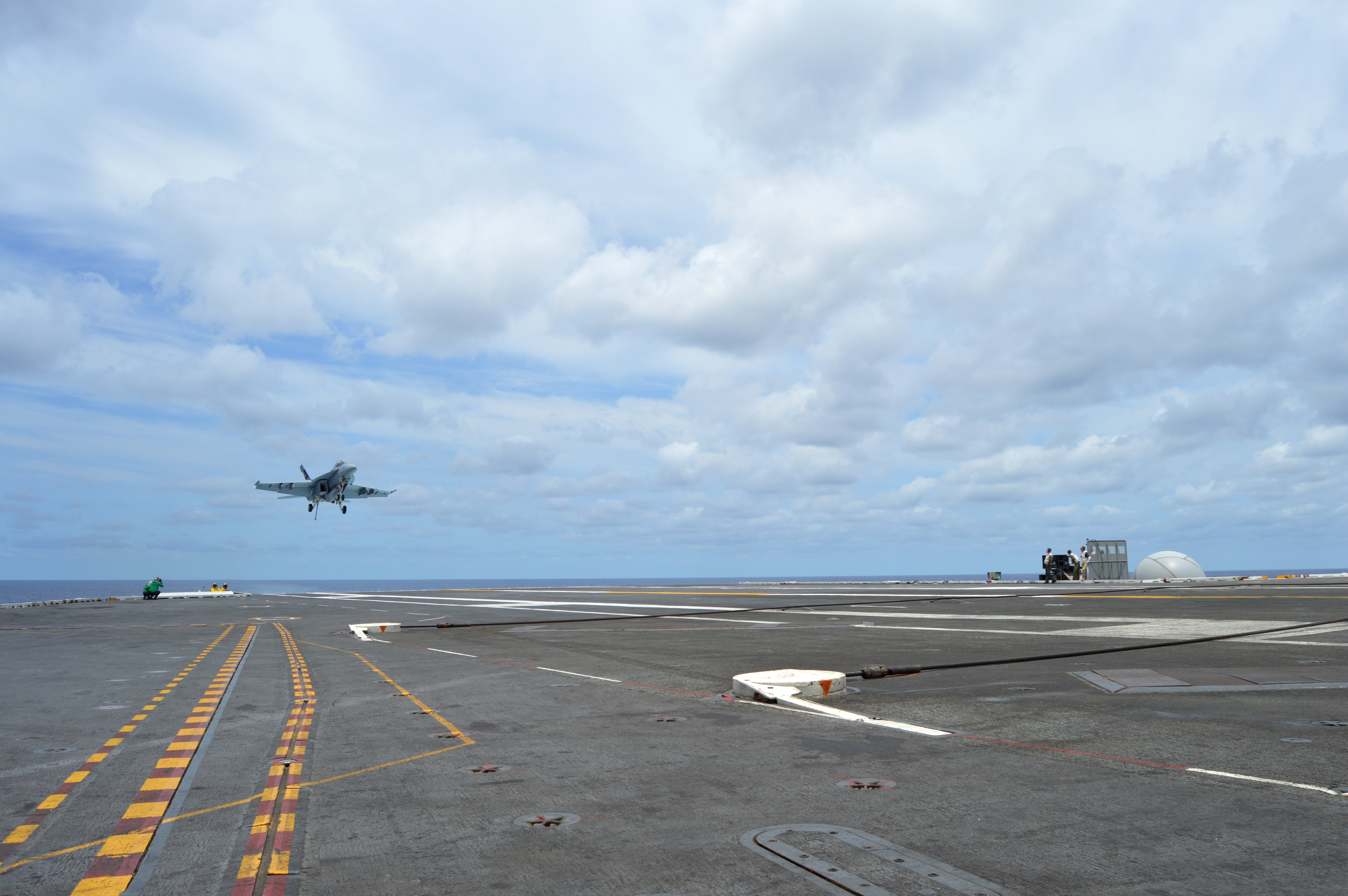
ABOARD USS GEORGE WASHINGTON, OFF THE COAST OF VIRGINIA – The Navy has completed testing of its MAGIC CARPET technology that simplifies the process of landing a fighter on an aircraft carrier – with data suggesting that pilots may make single-digit flight path corrections on final approach instead of hundreds and land “significantly” closer to their target on the flight deck, according to those involved in the testing.
The premise of MAGIC CARPET is simple – rather than worry about adjusting roll, yaw and pitch, adding and reducing power, and predicting how the plane’s course will intersect with the moving ship’s, the pilot can more directly and simply control flight path. And because the services’s Boeing F/A-18E/F Super Hornets and EA-18G Growlers have digital flight controls, MAGIC CARPET remaps those controls to do just that.
The Maritime Augmented Guidance with Integrated Controls for Carrier Approach and Recovery Precision Enabling Technologies (MAGIC CARPET), a collaboration by Naval Air Systems Command and the Office of Naval Research, was first tested aboard USS George H.W. Bush (CVN-77) last year and completed its final test aboard USS George Washington (CVN-73) this week ahead of an interim software version release this fall.
The Navy invited a small group of reporters to watch the final day of testing aboard the carrier to see first-hand how pilot workload is reduced and how that could ultimately affect the flight deck crew, pilot training requirements and even the aircraft maintenance and operations budgets.
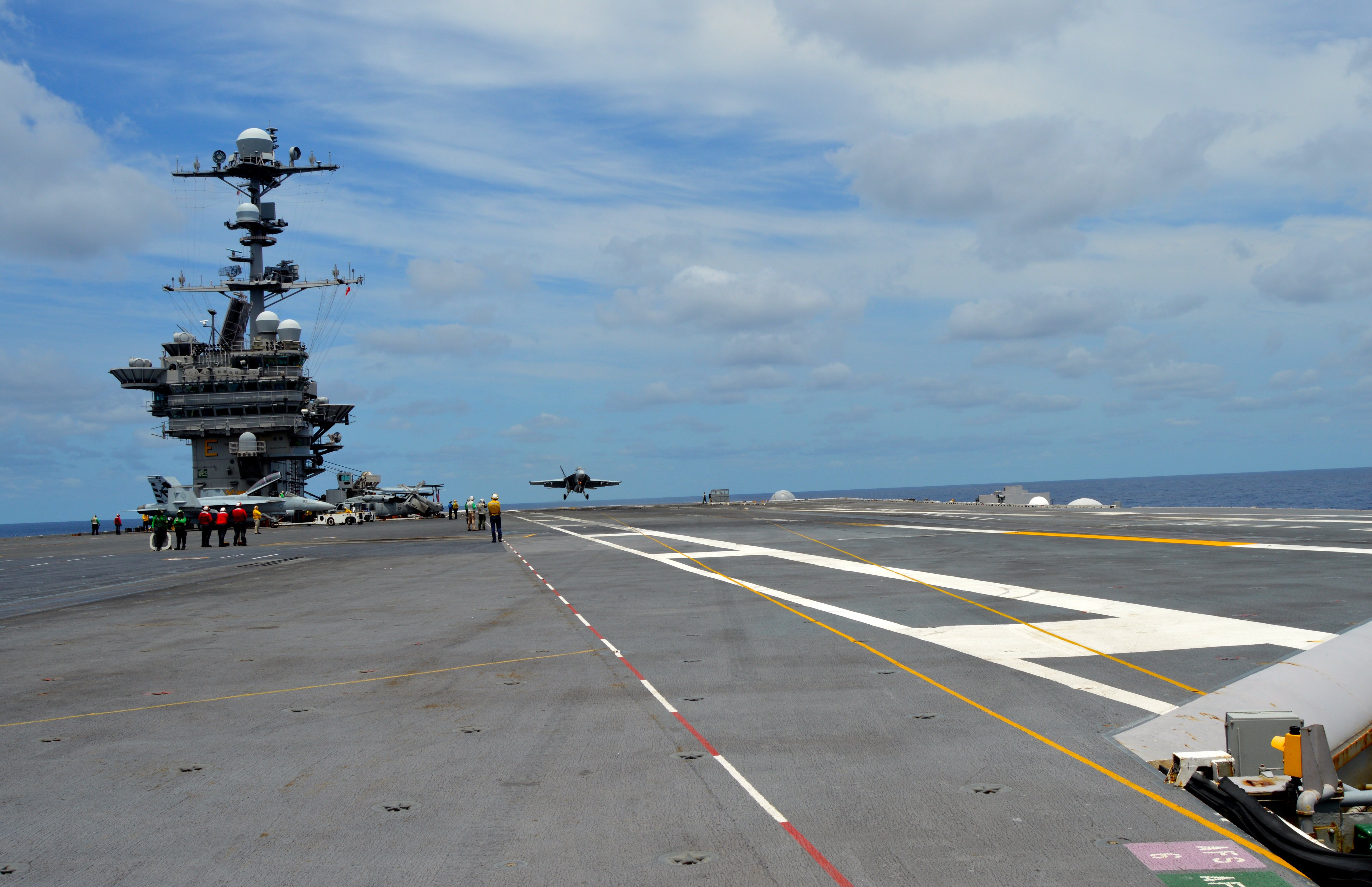
How MAGIC CARPET Works
MAGIC CARPET accomplishes three things through a software-only change to the airplane, with no changes whatsoever needed to the carrier receiving the fighters.
Capt. David Kindley, F/A-18 and EA-18G Program Manager in the Program Executive Office for Tactical Aircraft, explained that pilots approaching the carrier focus on three things: watching their lineup, with the goal being to catch the third of four wires in the aircraft arresting gear; angle of attack, needed to ensure the tailhook on the back of the plane catches a wire; and speed. Even if a pilot begins his approach to the ship perfectly, every little adjustment to maintain that path to the ship requires counter-adjustments in other areas – “just dozens of corrections, tiny corrections, that I’m making” for the final 18 seconds, called “flying on the ball.”
The Super Hornets and Growlers were built with digital flight controls, and some automation was built into the system from the start.
“We call it a living wing, you see the wing doing this (adjusting itself) all the time because I told it not to roll, and so any disturbance in the air mass that would make me roll, the airplane will compensate automatically,” Kindley explained, demonstrating the dynamic wing movement with his hands.
“So what we’ve basically done is taken that idea and applied it to landing, because I know most of the time I’m going to fly a 3-degree glideslope.”
When MAGIC CARPET is engaged and put into “delta path mode,” the plane will fly on a 3-degree glideslope downwards regardless of wind and other conditions outside. Even when the plane flies through the burble, or disturbed air behind the aircraft carrier’s island, the plane reacts and continues on its planned glideslope.
Then, MAGIC CARPET allows for more intuitive and much less cumbersome adjustments to that flight path by decoupling roll from yaw from pitch, and instead creating a single input that affects the ultimate goal – the airplane’s flight path. The pilot can make a little correction to the flight path using the stick and then simply let go of the stick to stay on that new path.
“I’ve never seen anything like this before,” Kindley said. If a pilot is coming in high, “you just push the stick forward and then let go, and it stops itself on glideslope. Same thing when I’m below glideslope, you just pull the stick back and then let go. So instead of making multiple corrections with the throttle and stick to affect glideslope, I’ve made one and then let go.”
The same is true for side-to-side corrections – the pilot adjusts and then lets go of the stick to maintain the new direction, with the plane always keeping that same 3-degree glideslope for a smooth landing on the carrier flight deck.
Finally, MAGIC CARPET calculates the movement of the carrier as it sails through the water and precisely understands where the landing area will be by the time the fighter gets to it. Today, pilots have to constantly guess the velocity vector, Kindley said, and find themselves “spotting the deck” – which often times puts them too low and may cause the Landing Signal Officer (LSO) on the flight deck to wave them off.
With this new tool, “we can look at how fast the ship is moving, it’s not a hard math problem – if I know how fast the ship is moving here then I can figure out how fast the runway is moving to the right, and so I can just, I go into delta path mode and we have a different symbol, velocity vector goes away and it actually looks like a little landing area. So no kidding, all you do is you put the landing area on the landing area, and then you let go. It’s really that simple.”
Ultimately, Kindley said, MAGIC CARPET “makes it so the plane is working for you instead of against you” while landing.
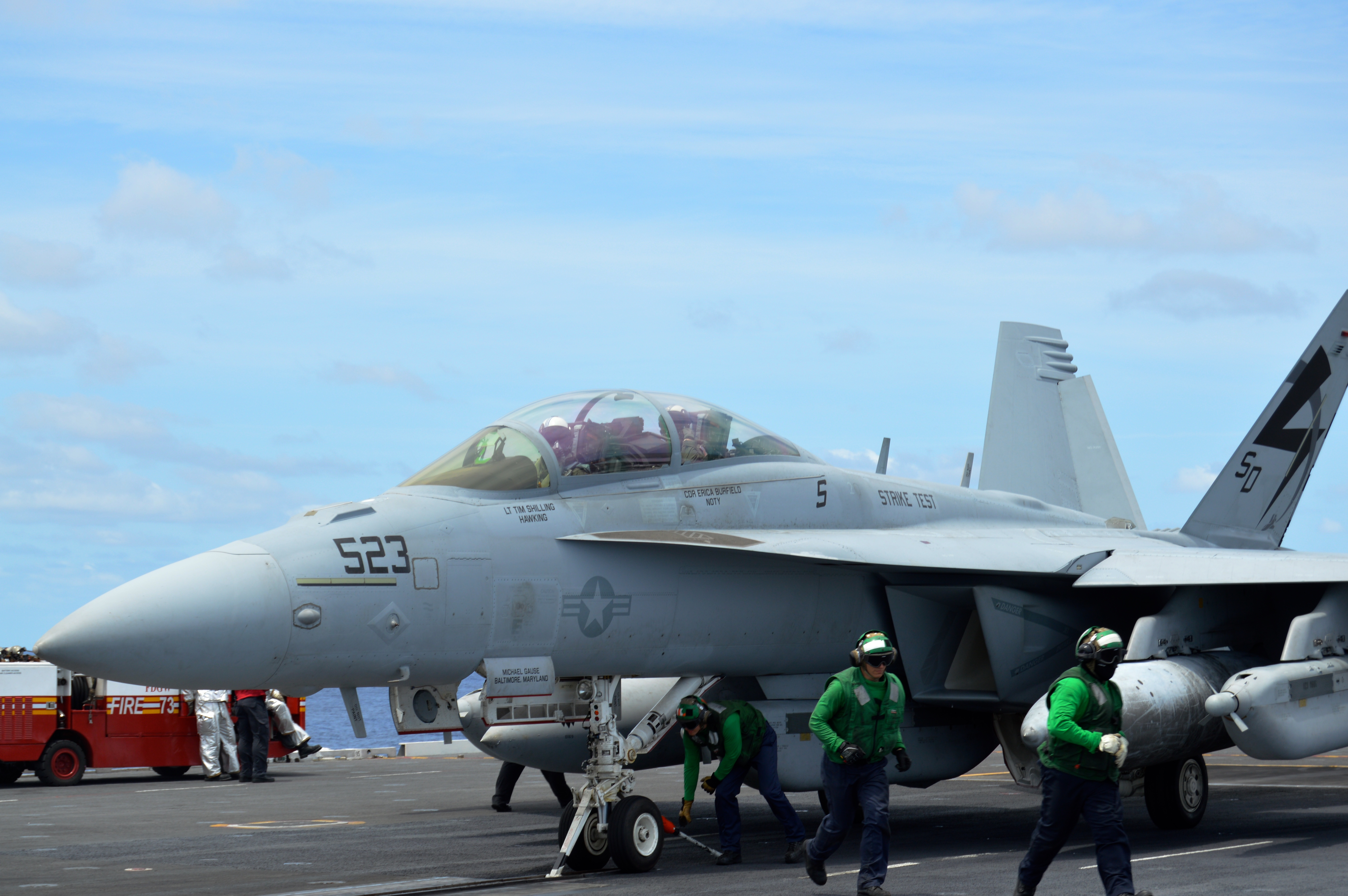
Test Pilots’ Perspective
Navy pilots see landing on the aircraft carrier as an administrative task: “It’s like filling out paperwork, you have to do it in order to do what you really want to do,” Lt. Cmdr. Matthew Dominick, a test pilot in the carrier suitability flight test department in the VX-23 Air Test and Evaluation Squadron, told reporters after testing wrapped up.
For as uninteresting a task as pilots consider landing – it allows a brief respite for the pilot and a chance to refuel and rearm the plane before going back out to continue the mission – carrier landings are among the most dangerous things a pilot will do.
Using the “closest alligator to the canoe” as an analogy – of all the dangers, he’s most concerned about fending off the one nearest to him so he can survive a bit longer – Dominick said “when we are not at war, the closest alligator to the canoe, to me, to threatening what we’re going to do and the risk we take, is landing aboard the ship. It’s dangerous, it’s every day regardless of whether we’re at war or not at war. … After all of the stress of that combat mission, where people are yelling and things are going on and bombs are getting dropped, you still have to come back to this really really dangerous thing. So will this change carrier aviation? Yes. We can start focusing more time and training to focus on that other mission because this closer alligator to the canoe has been subdued.”
Dominick, who has 11 years of flight experience in the Navy, said that a pilot’s time flying on the ball is considered “sacrosanct.” No one will talk to the pilot over the radio during that time except for the LSO on the flight deck to keep the pilot safe – but otherwise, everyone knows the pilot needs total silence to focus on the task at hand.
During MAGIC CARPET testing, though – two three-hour periods a day from June 23 to 27 – “now with this system, when we’re flying the ball, we are talking the entire way down about exactly what we’re seeing. … We’re talking to the engineers real time all the way to touchdown.”
Kindley said the average pilot makes 200 to 300 corrections in the final 18 seconds before landing. With MAGIC CARPET, test data showed the first-timers making about 20 corrections while flying on the ball, with that figure dropping below 10 once the pilots got used to the system.
Test pilot Lt. Christopher Montague explained that decrease in rapid-fire movements in basic terms. When the testing first started, the pilots came in to the carrier with a “nominal approach,” following the basic parameters pilots are taught to aim for as they begin their approach. After seeing how MAGIC CARPET responded, the pilots then began off-nominal approaches – coming in too high or low, too fast or slow, overshooting or undershooting the runway – “stressing the system, so you force yourself in there to make some aggressive inputs” before successfully landing.
During one pass that Montague meant to overshoot but accidentally significantly overshot, “I probably would have been told to wave off before I even started my approach. As I was coming through, Paddles (the LSO) probably would have said, wave off wave off, maybe take it up the starboard side of the ship, which would have been very embarrassing for me. So, however, I didn’t, I stuck with it (using MAGIC CARPET) … and I landed with the center ball back on center line with about four or five seconds left to go. So it was pretty eye-opening to me, the power of the system. And that was loaded with about as much asymmetry on the aircraft as we could,” meaning one wing was fully loaded with ordnance or fuel and the other was empty, as a way of stressing the system as much as the testers could.
In that scenario, without MAGIC CARPET “the throttles would have been going anywhere between idle and full power and hopefully not into after burner. But I would have been, we sometimes call it sawing logs, I would have been doing that all over the place,” Montague said. With MAGIC CARPET, “I think it’s probably reasonable to say probably at least 50 percent less control inputs. And that was on way off-nominal,” he said, with more nominal approaches resulting in even fewer control inputs while on the ball.
“I am still uncomfortable with how few inputs I’m making,” Dominick said, noting it can feel a little counter to all the years of training and experience at first, but the system has earned his trust – particularly once he started the intentionally off-nominal passes.
Dominick said it was important to keep in mind that MAGIC CARPET is not an automated landing system – the pilots are still flying the plane, and human error and bad weather conditions will still make carrier landings risky. But, he said, “we just changed the way you control the airplane – we made it respond faster and better.”
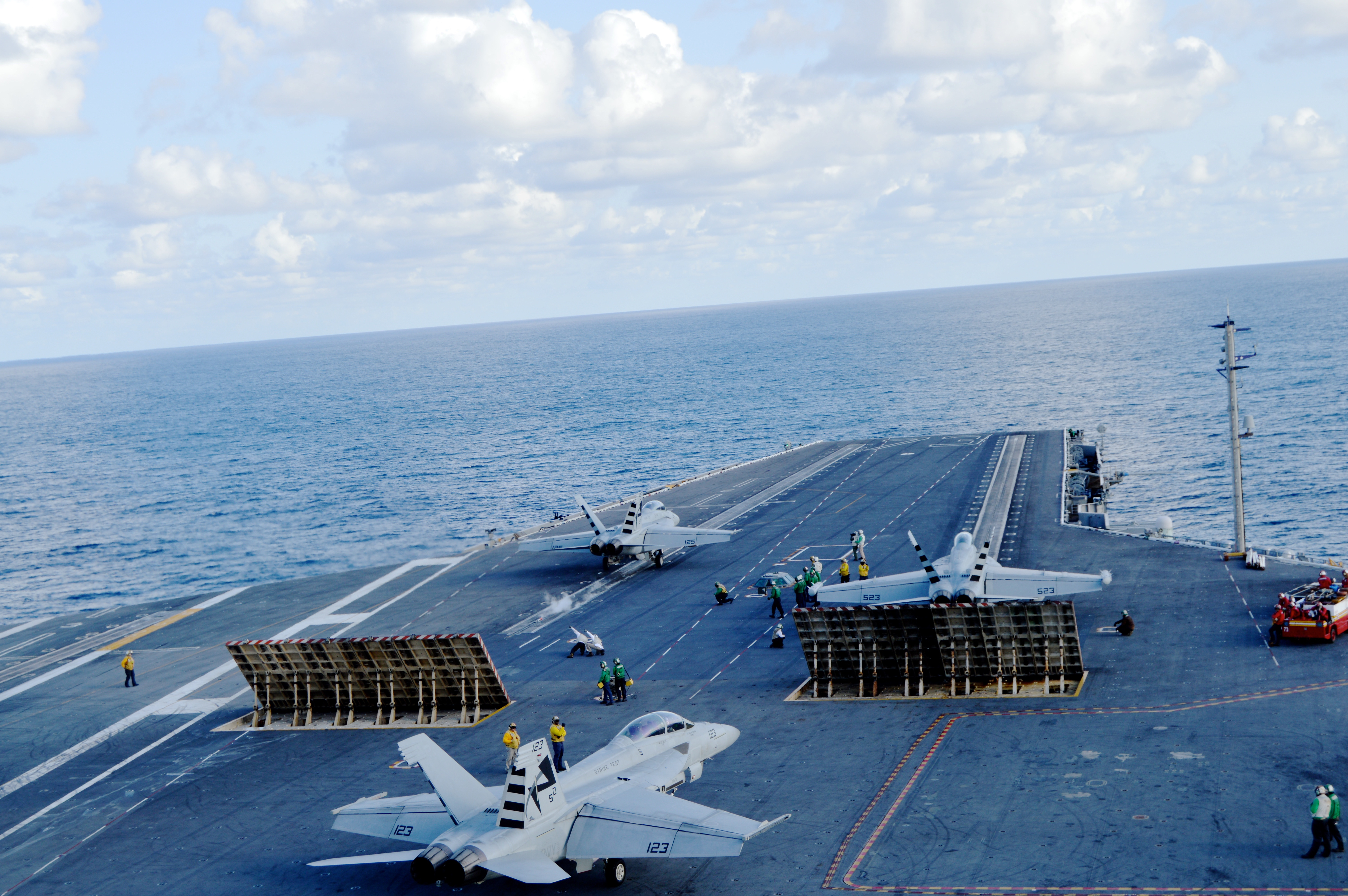
The Fleet’s Perspective
Aircraft carriers, despite existing to move aircraft around, do not like launching and recovering planes.
“From the ship’s perspective, ship’s don’t like to recover airplanes because their maneuverability is very constrained. The ship has a contract with me as an aviator to put the wind right down the angle at a set speed so I have very constant conditions – I don’t like crosswinds, I don’t like varying speed, I want everything to be constant,” Kindley said.
“So the ship is constrained to what it can give me for the length of time it takes to get these airplanes landed. Now that’s bad for a couple of reasons. One, if I want to go there but the winds are coming from here, the carrier’s going this way. He’s going the wrong direction. Two, places like the Arabian Gulf, there’s shipping everywhere and the carrier has to not hit these people, so his maneuverability is significantly constrained when he’s bringing airplanes aboard. So the less time we constrain him like that, the better.”
Cmdr. Michael Bratley, George Washington’s air officer, said MAGIC CARPET could help his job in a lot of ways. It would reduce the amount of time he makes the ship’s commanding officer put the ship into the wind instead of on course to its destination. It reduces the amount of time he has to worry about protecting air space around the ship, as well as keeping a helicopter with search and rescue swimmers in the air in case of a mishap.
Additionally, Bratley noted that the system reduces the rate of bolters – when the plane’s tailhook misses the wire and the plane has to circle around and try again. Bolters not only slow down the planes waiting in the queue to come in, but if a plane is struggling to land and starts running low on fuel it would either have to go to a tanker for aerial refueling or be diverted to a nearby landing area ashore.
Of 598 passes during the testing period, there was only one bolter – whereas Dominick said during a normal deployment with that much flying each pilot would likely have a couple really scary landings and plenty more bolters.
In fact, the data collected shows that the landings were much more concentrated near the 3 wire, such that this low bolter rate could likely continue once put in the hands of fleet pilots.
Buddy Denham, a senior engineer at the aeromechanics division of Naval Air Systems Command, said that high-speed photographic equipment measured touchdowns from the bridge of the carrier this year for comparison to similar data collected during carrier qualifications on a different ship last year.
In last year’s outing, some pilots were landing on the carrier for their first time, while others were more experienced. With the halfway point between the 2 and 3 wire being the target, 66 percent of the touchdowns occurred at plus or minus 40 feet from the target.
With MAGIC CARPET testing, 66 percent of the landings were plus or minus 18 feet from the target – a much more consistent and accurate landing pattern, Denham said, calling it an “eye-opening performance” that almost exactly matched what he expected to see.
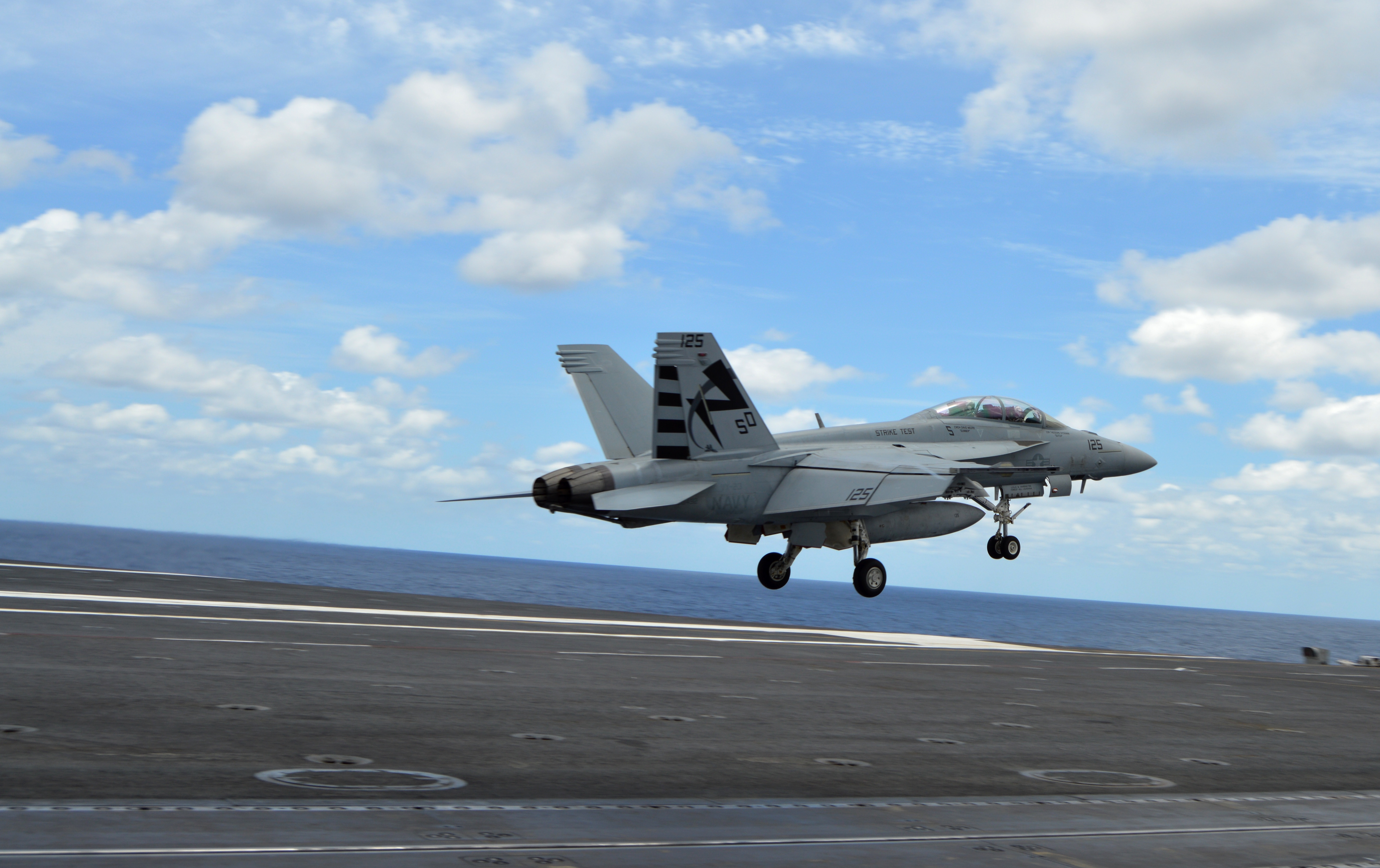
He noted that the test pilots are more experienced and selected for their jobs based on talent – so in that sense you’d expect better landings from them. However, since their passes included not only off-nominal approaches on the pilots’ part, but also the ship creating winds in excess of 48 knots, very low winds, crosswinds and more, Denham said the dispersion chart speaks for itself.
Ultimately, he said, this proves that MAGIC CARPET will go a long way in “making sure that the fleet guy that ends up there, that the airplane’s easily controllable, you have the capability in the airplane to get it back on glideslope in time to have that performance landing” and get safely back aboard the ship.
Kindley cautioned against reading too much into the early data, but he said he was confident that, to a yet-unknown degree, several improvements would come of this technology.
First and foremost is increased pilot safety. During testing, the pilots were consistently hitting the third wire, with smooth approaches and no hard landings.
“If we’ve really done that, if we’ve really managed to make it that easy, then what do we have to do to get ready to go to sea?” he said.
“Well, we’ll probably still get in a place where we have to get our mindsets into landing, but do I need to spend the amount of time in the future preparing for the ship as I do now? I think it will be less,” though it would be up to the commander of Naval Air Forces to decide how much less training pilots would receive for carrier landings at sea.
Training time is precious though, he said, and while increasingly capable technologies are becoming available for combat, sailors are lagging in their ability to learn and master those technologies.
“Every minute that I give back to them in training is precious to us, so I’d rather remove that from this administrative task of getting aboard a ship and give it back” to preparing for the increasingly challenging warfighting tasks the pilots will be asked to perform.
Additionally, MAGIC CARPET could extend the life of the Super Hornets and Growlers, or at the very least reduce the maintenance required to keep them combat ready.
Kindley, who oversees the entire fighter portfolio – including the Super Hornet service life extension effort – said that “if I can get to a level of consistency here where I’m touching down with the same parameters in rate of descent, same parameters in drift rate … same parameters on the strain I’m putting on the landing gear, all of those things become much more stable, then we have done a really good thing in terms of the long-term support of the airplane.”
“I can’t quantify this, but I know for a fact that if I’m seeing the consistency in landings that we’ve seen so far in test,” then the stress on the planes and therefore maintenance required would be reduced, he said.
As airframes are taken out of service to undergo that service life extension program when they hit 6,000 flight hours, an existing fighter shortfall will be exacerbated, making every single airplane important for fleet readiness. However, the ships’ commanding officers are required to designate Super Hornets to serve as tankers instead – when Kindley commanded the Kestrels of Strike Fighter Squadron (VFA) 137, he and the other Super Hornet squadron had to give up a combined five airplanes to be reconfigured as tankers to support planes running low on fuel – particularly as a result of boltering.
“We have to have tankers airborne day and night just in case that occurs, but if (MAGIC CARPET) made it this easy, maybe I don’t have to devote that many planes to be tankers,” Kindley said.
“Maybe I can take two or three or several of those airplanes and configure them back as strike fighters, so now the air wing has those airplanes to work with as strike fighters and doesn’t have to designate them as tankers.”
Of course none of these benefits will be seen immediately, he noted. On the issue of tankers, for example, the ship CO decides how many to have based on the risk involved in the upcoming deployment, personal preference and all manner of factors. Kindley said he expects to see a five-tanker requirement “for a while until we’re convincing the ship that (MAGIC CARPET) is good.”
But the ships keep track of bolter numbers and aerial refueling, and “over time, if we no kidding start to see the numbers of getting aboard change, if we really are seeing 3 wires, 3 wires, 3 wires, we’re not seeing early wires like 1 wires or scary passes and we’re not seeing bolters, over time the ship guys are going to go, oh, you know what, we can accept a little bit more risk.”
“I think the data will drive it as we start to prove the performance,” he continued.
“I don’t think it’s going to happen tomorrow, and I think it will be left up to the units to make the call.”
But, Kindley concluded, “the more you start thinking about what all of this could do in terms of benefit to the fleet, it gets better and better and better.”
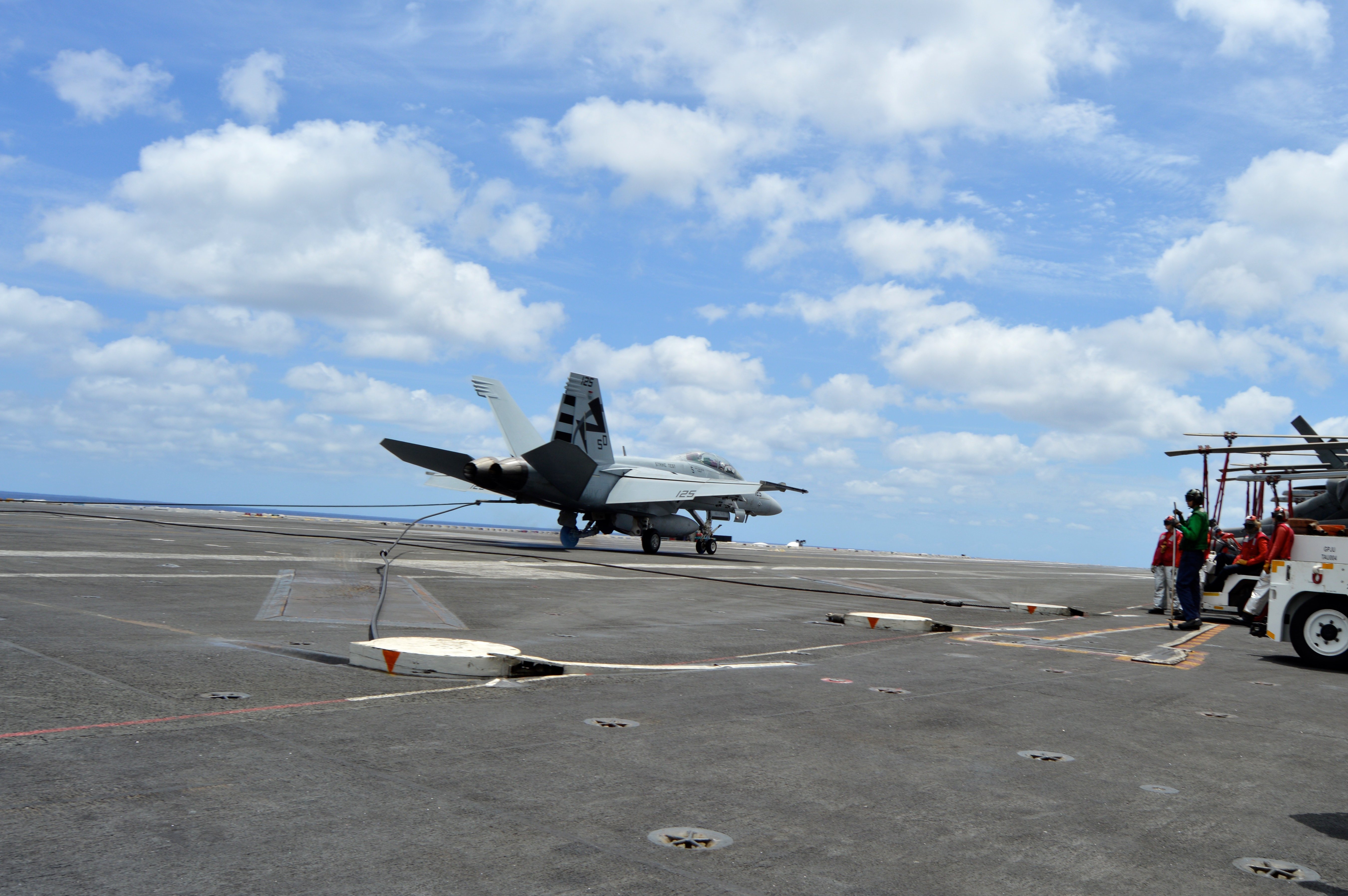
Path to Fleet Introduction
Kindley said he sees the fleet eventually being as reliant on MAGIC CARPET as it is today on the Heads-Up Display (HUD).
“But in order to do that and still sleep at night, I’ve got to make MAGIC CARPET as reliable as the HUD is,” and he said the program isn’t quite there yet.
The test pilots aboard George Washington flew the software version H-10. This fall, once any last issues that arose during testing are fixed, an H-10+ will be fielded for fleet experimentation only.
An H-12 version of the software will be available in simulators in the spring of 2017 and will be delivered for operational testing in the fall of 2017. And the H-14 software, the one intended for fleet-wide fielding, will go to operational test in the fall of 2018 and deliver in 2019.
The main upgrade H-14 will bring is failure modes – the proven ability to continue to make safe carrier landings even if the throttle control breaks, or the navigation system fails, or the wings have been shot at. Kindley said the fleet will need that level of certainty in the system before even considering reducing training or taking on risk with fewer tankers.
Still, rather than wait for 2019 to start fleet introduction, “my idea was, we’re going to give this to the fleet and they’re going to just start to screw around with it,” he said. Pilots already do “circus passes” to practice landing without the HUD or other tools, so MAGIC CARPET passes could be incorporated into the mix.
“On a day like today when it’s beautiful and everything’s going well, we’re going to get the fleet into delta path and they’re going to see what they can do with it,” he said.
This will also help generate more data on fuel savings, maintenance savings, potential training savings and more, to help the naval aviation community understand how to field the system.
“I’m afraid to go commit to anything right now because I don’t even know what the fleet’s going to do,” Kindley said.
“I know this is really good. and I think it could be crazy good, but I don’t have a sense of the quantity of that. So the interim capability goes this year, the final capability still on plan for 2019,” and then the fleet can think about “what checks we can write” in terms of cost savings.
Even as the program office continues to work on the H-12 and H-14 software upgrades, the H-10 software that was just tested will go to an Operator Assessment Group run by the LSO school, where fleet LSOs will talk to the engineers involved in the program – as well as one fleet LSO who was invited out to participate in the GW test period – to think about how MAGIC CARPET could and should alter fleet operations. The LSO school will then make recommendations to the commander of Naval Air Forces – Air Boss Vice Adm. Mike Shoemaker – about future courses of action.
Adopting MAGIC CARPET may not be a hard sell if development and testing continues to go well: Shoemaker is already a fan.
“Initial testing of this technology gives me great confidence that MAGIC CARPET, along with similar efforts with the F-35C and its carrier landing control laws, will reduce utilization of our airframes, minimize the number of hard landings and required maintenance inspections, and increase our aircraft availability rate. I am excited to get this technology to the fleet and look forward to what it will bring to the fight,” he said in a statement after the GW testing concluded.
“I am confident this capability will not only simplify the pilot’s workload during landing and increase overall boarding rate, but will also improve the overall efficiency of carrier aviation through streamlined initial and currency training requirements for our pilots and reduced aerial refueling requirements during carrier operations, freeing up our Super Hornets for mission tasking.”





